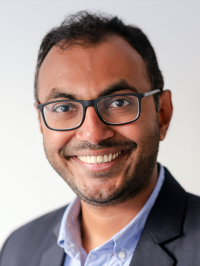
Assistant Professor
Email: kasun.gunasooriya@ou.edu
Phone: +1 (405) 325-3518
Office: Sarkeys Energy Center, T-311
Website
Google Scholar
Education
Ph.D. Chemical Engineering, 2019
Ghent University, Belgium
M.Eng. Chemical and Biomolecular Engineering, 2014
National University of Singapore (NUS), Singapore
B.Eng. Chemical and Biomolecular Engineering, 2011
Minor in Nanoscience
National University of Singapore (NUS), Singapore
Kasun Gunasooriya is an assistant professor in the School of Sustainable Chemical, Biological and Materials Engineering at the University of Oklahoma. The overarching goal of his research group is to develop innovative strategies to produce renewable energy, fuels, and chemicals by the computational design of efficient thermo- and electro-catalytic processes. To achieve this, Gunasooriya Lab combines expertise in the fields of computational catalysis, kinetic modeling, continuum modeling, and machine learning, with a special focus on underpinning structure-property relationships of advanced catalytic materials to accelerate materials discovery and establish catalyst design principles for sustainable energy applications.
Before OU, he was a postdoctoral fellow with Prof. Jens K. Nørskov at the Catalysis Theory Center at the Technical University of Denmark (DTU). His research at DTU focused on developing novel catalytic materials for water electrolyzers and fuel cells in close experimental collaboration with Prof. Thomas Jaramillo at Stanford University and Prof. Ib Chorkendorff at DTU. He earned his B.Eng. and M.Eng in Chemical Engineering from the National University of Singapore (NUS) and carried out his Ph.D. research with Prof. Mark Saeys and Prof. Guy Marin at the Laboratory for Chemical Technology (LCT) at the Ghent University, where he investigated the catalyst structure and reaction mechanism of the cobalt catalyzed Fischer-Tropsch Synthesis.
Research Focus
Awards
Experience
Research Vision
Uncertainty over the future security of our energy is a major concern with a rising global population, increasing energy demands, and impending climate change. The discovery and consumption of massive quantities of carbon-based energy sources such as fossil fuels (coal, oil, natural gas) have contributed to our modern high standard of living, but, unfortunately at the expense of the climate due to CO₂ emissions. However, a drastic change away from a carbon-based society is not expected in the near future.
Therefore, to overcome the aforementioned challenges;
(1) in the short-term: a constant strive for higher yields, increased selectivity, and improved energy efficiency for existing processes in the chemical industry, as well as the development of innovative new selective processes
(2) in the long-term: a transition to a society based on CO₂-neutral sustainable energy resources (solar, wind, and hydroelectric) is essential for the sustainability of modern civilization.
This will require immense scientific and technological developments in processes that transform low carbon feedstocks (CO2 and CH4) into fuels and chemicals, and renewable energy capture, storage, and conversion devices. These processes and devices rely strongly on catalytic materials in order to attain the required performance involved in their operation. However, today’s catalytic materials are inadequate. Therefore, the grand challenge is to design and discover advanced catalytic materials that satisfy activity, selectivity, and stability, and are based on Earth-abundant and non-critical elements to achieve a sustainable energy future.
For more information, please visit our lab website (https://www.gunasooriya-lab.com/).